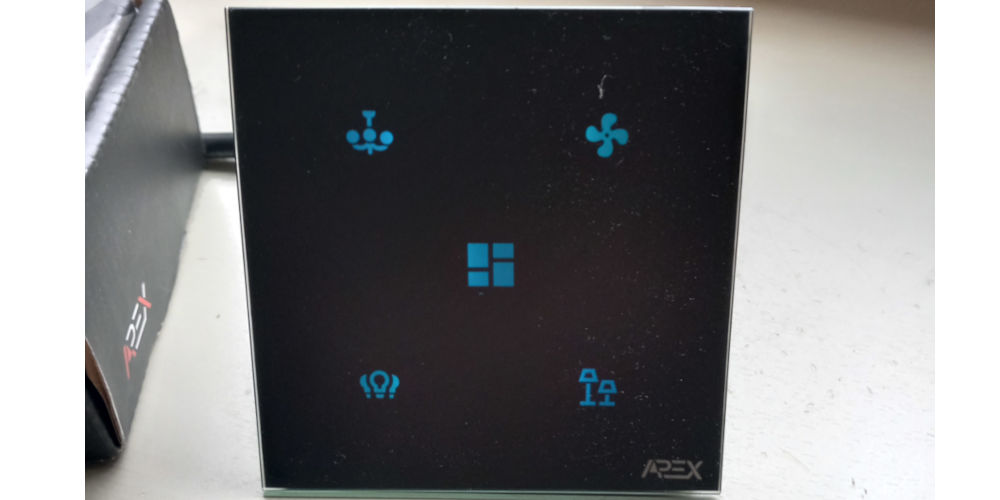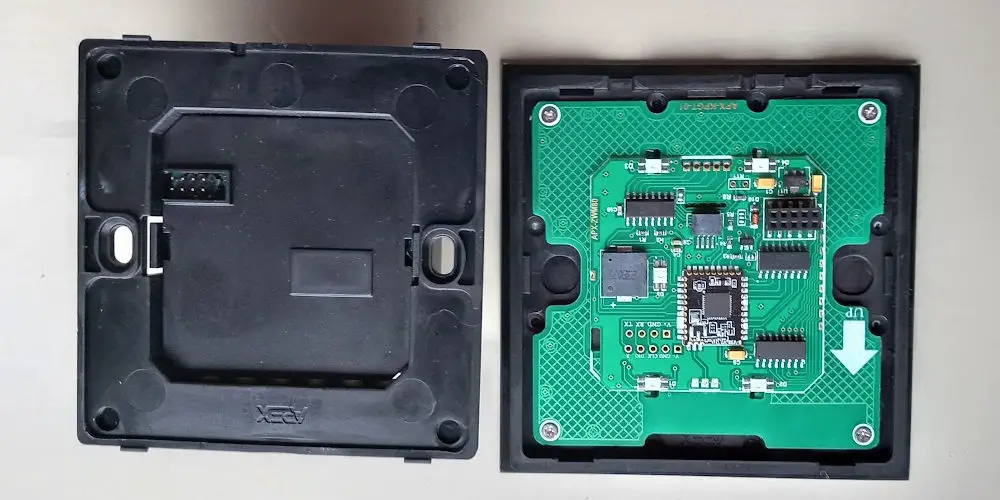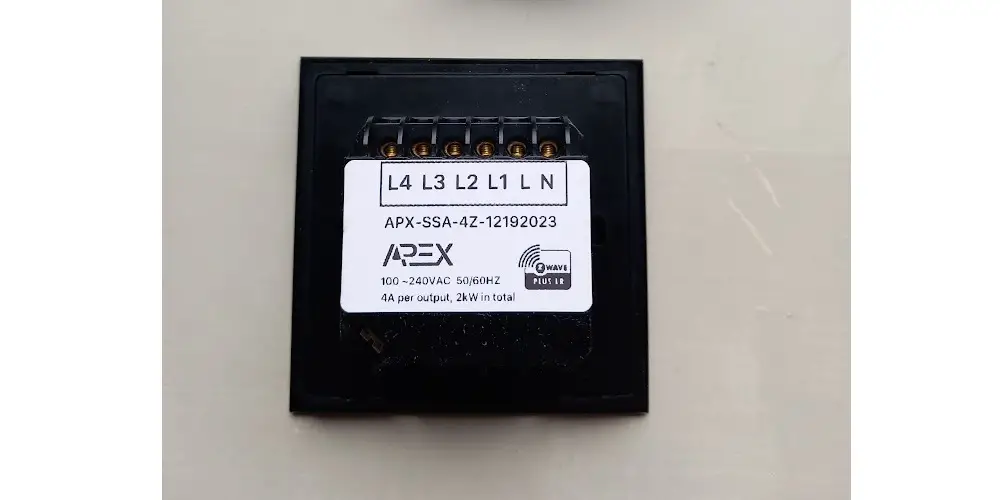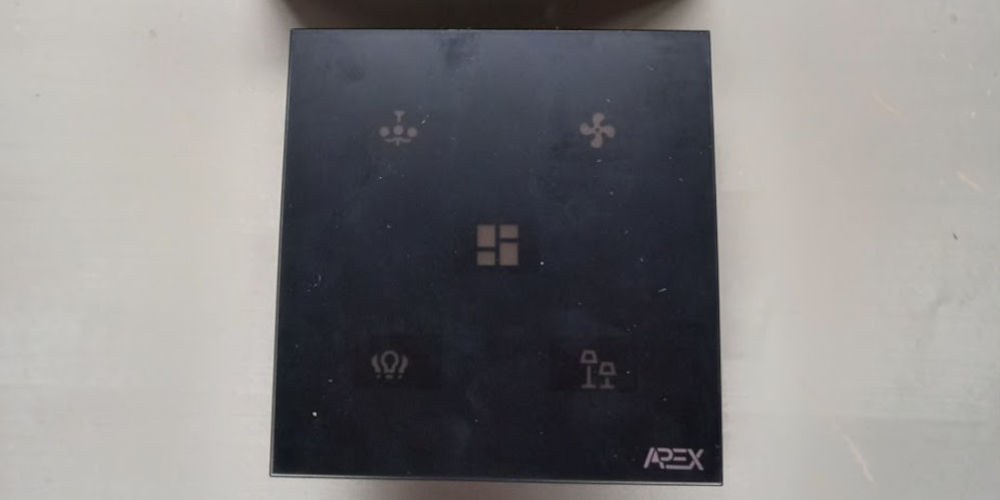APEX Crystal Series Z-Wave switch review

Last November, I discovered APEX on a Fibaro Facebook Group and knew I had to order one of their switches. Ehsan, their head of sales, made the process easy, and he’s super helpful. APEX Crystal Series Z-Wave switch covers several functions, including device control and scene selector.
I’ve spent quite a bit of time in the last 6 months searching for Z-Wave scene controllers on the EU frequency. I’m not a fan of having a load of wall switches or having to remember the settings that make up a scene. I want simple control over a complex system! But more on that later.
We’ve covered a few here, including the Z-Push and MCO range. I even talked to the head of product design at Heltun. All of these are great devices. However, they require you to customise them with labels or an engraving machine.
I even talked with the marketing manager of Rithum, which is a customisable touch screen that works with devices from several leading brands, including Fibaro, Sonos, and Philips Hue.
The APEX Crystal Series Z-Wave switch uses easy to change icons to denote what each button controls. A pack of 40 icons comes with the switch, making it highly customisable with little effort.
It solves my problem of having an attractive scene controller that’s easy to customise and works with my Fibaro Home Center 3 Lite and Z-wave. If you’re suffering from the same issue, your search might be over.
Exploring APEX devices and their Crystal Series
Until meeting Ehsan, I hadn’t heard of APEX, despite them being around since 2013. They offer devices for Control4, Z-Wave, and Can_Bus, including smart light switches and Din-mounted modules.
In terms of Z-Wave, they offer 4 product ranges: Classic, Crystal, Touch Pro, and Luxie. Two ranges really stood out for me, the Classic and Crystal.
Their Classic range includes keypad switches and thermostatic keypad switches. Both have a modern appearance but can also be engraved. Hopefully, we’ll get some of these models in for review soon.
What attracted me to the Crystal Series is a few elements. Firstly, they are available in 1 to 5 button configurations. So, you can choose the ideal unit for the situation and aren’t limited to a one-size-fits-all.
They can control devices using built-in relays or activate scenes. Also, they use changeable icons to indicate what each button does, making them super flexible.
I purchased a 5 button APEX Crystal Series Z-Wave switch as this was the best option to solve my problem and do so affordably.
Why use it as a scene controller?
While you can use both the Crystal and Smart Series to control devices, I plan to use them to select scenes. The reason is quite simple. I don’t want a row of switches and controls in each room, nor do I want to have to remember the ideal settings and try to recreate them every time.
I’m trying to reduce the thousands of possible options to 3 or 4 preset scenes that cover 90% of how I want to use the devices in that room. Next, I want to be able to easily activate these scenes. If I need to make finer adjustments, I can use the Yubii app or online portal.
If this is a little tricky to understand, here’s a real-life example of how I’m using scenes to simplify my life.
On most Friday nights, I like to unwind with a movie. So, I’ve built a Movie scene that closes the curtains, dims the light to 30%, increases the temperature by 5 degrees, and turns the TV on (which then turns on the soundbar – thanks to HDMI ARC!).
I don’t need to think about the optimum settings or what each device is doing, as I’ve spent time before programming the system. I simply hit the Movie button in the Yubii app or on the APEX switch, and have the system take care of it for me!

What comes in the box with the APEX Crystal Series Z-Wave switch?
The APEX Crystal Series Z-Wave switch arrives in two parts, the faceplate and the body. They connect using a multi-pin connector and are easy to join together. By arriving in two parts, you can easily unscrew the face place and change the icons before putting the unit together.
In the box are two wall screws, a manual, and a pack of 40 icons. They have And so getting it installed and customised for your home is straightforward.
Installing the device and pairing it with a hub
To power the unit, it requires live and neutral wires. If you’ve changed a light switch, you’ll know we typically only have a live wire and a switch live wire. It’s more common in the EU and US to also have a neutral wire at the switch.
There are a few ways to get the required power to the unit. You could tweak the cables at the lighting rose as you have a neutral wire up there. Another option is to use a 240-volt power cable connected to a mains socket.
As I had a few old IEC cables lying around, I decided to decapitate one and use the live and neutral wires to feed the APEX device. It worked perfectly!
With the device powered, I pressed the bottom right button for a few seconds until it started flashing, indicating it was running inclusion mode. Next, with my phone, I loaded the Yubii app and went through the steps to add a new Z-Wave device.
It only took a few minutes to get the APEX switch added to my Fibaro system and ready to programme.

Programming the APEX switch with the Fibaro Home Center 3 Lite
While I’ve been looking for a scene controller, I’ve spent time on Fibaro’s online portal building scenes. Currently, I have 14 scenes in various stages of creation. Some are complete and are being used regularly. Others are waiting for devices to be installed before a final tweak.
The APEX switch allows you to assign scenes or associations to 3 inputs. There is a single press, long press, and release press. You could programme each button to handle 3 different actions.
My living room currently has automated curtains, side lights, a pendant light, and Arylic A30+ HI-Fi, which all are part of my Fibaro HC3 Lite system. I also have a TV and soundbar with a subwoofer, which will be shortly added into the system using an IR to Z-Wave device.
I’ve built scenes for Morning, Meeting, Movie, and Room off, allowing me to simplify control and use the APEX switch effectively. These scenes allow me to live comfortably while controlling the room the way I want to.
I started by using the single press to activate the different scenes. After a few minutes, I changed the Room Off scene to be controlled by a long press to avoid any accidents. It took a second to make this change as Fibaro Block Scene builder is very easy to use.
Using the APEX Z-Wave switch
So what do the 4 scenes (Morning, Meeting, Movie, and Room off)?
The Morning scene turns on the light for 10 minutes and opens the curtains. Ideal for the morning coffee.
With the Meeting scene, it turns on the pendant light to 100%, switches the side lamps on, and ensures the curtains are open. It’s ideal for Zoom calls or seeing friends.
Friday and weekends are where I use the Movie scene the most. The pendant light dims to 30%, the curtains close, and all other devices are turned off. In the future, the TV and soundbar will turn on as part of this scene.
Finally, the Room off scene simply turns all the devices off. I could add the curtains to the automation but haven’t just yet.
I’m using a Global off scene to turn every device off and close the blinds and curtains within my house. Currently, I am activating this scene from my phone using the Yubii app. In the future, I’ll be using another APEX switch in my bedroom to control this scene, using a long press.

How does it compare to other options?
In my search for a Z-Wave scene controller, I’ve tested several options. These include the Heatit Z-Push, which is a great unit. However, it’s battery-powered and requires engraving, meaning you can’t easily change its function.
I also purchased a Sunricher SR-ZV2833PAC from eBay, which allows you to connect up to 4 switches and activate up to 4 scenes. While I liked the idea of this unit, I couldn’t find a UK retailer so I could buy more. So it was a non-starter.
There were a few other units I looked into but didn’t try, including the Heltun range and MCO home range. However, since using the APEX, I have no need to explore these options further.
The APEX Crystal Series Z-Wave switch solves my problem of wanting a scene controller that’s mains powered, easy to customise, and flexible. Yes, it requires you to find a neutral wire, but that’s a small problem to overcome. They also offer a high capacity non-neutral version that works in a similar fashion.
In time, I’ll order more APEX switches as I continue expanding my Fibaro Z-Wave system as they’ll make controlling it simple, seamless, and guest-friendly.




